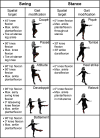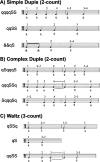This is a preprint.
Associations between music and dance relationships, rhythmic proficiency, and spatiotemporal movement modulation ability in adults with and without mild cognitive impairment
- PMID: 38187592
- PMCID: PMC10769308
- DOI: 10.1101/2023.12.19.572238
Associations between music and dance relationships, rhythmic proficiency, and spatiotemporal movement modulation ability in adults with and without mild cognitive impairment
Update in
-
Associations between music and dance relationships, rhythmic proficiency, and spatiotemporal movement modulation ability in adults with and without mild cognitive impairment.J Alzheimers Dis. 2025 Jun;105(4):1165-1182. doi: 10.3233/JAD-231453. Epub 2024 Jul 6. J Alzheimers Dis. 2025. PMID: 38995778
Abstract
Background: Personalized dance-based movement therapies may improve cognitive and motor function in individuals with mild cognitive impairment (MCI), a precursor to Alzheimer's disease. While age- and MCI-related deficits reduce individuals' abilities to perform dance-like rhythmic movement sequences (RMS)-spatial and temporal modifications to movement-it remains unclear how individuals' relationships to dance and music affect their ability to perform RMS.
Objective: Characterize associations between RMS performance and music or dance relationships, as well as the ability to perceive rhythm and meter (rhythmic proficiency) in adults with and without MCI.
Methods: We used wearable inertial sensors to evaluate the ability of 12 young adults (YA; age=23.9±4.2 yrs; 9F), 26 older adults without MCI (OA; age=68.1±8.5 yrs; 16F), and 18 adults with MCI (MCI; age=70.8±6.2 yrs; 10F) to accurately perform spatial, temporal, and spatiotemporal RMS. To quantify self-reported music and dance relationships and rhythmic proficiency, we developed Music (MRQ) and Dance Relationship Questionnaires (DRQ), and a rhythm assessment (RA), respectively. We correlated MRQ, DRQ, and RA scores against RMS performance for each group separately.
Results: The OA and YA groups exhibited better MRQ and RA scores than the MCI group (p<0.006). Better MRQ and RA scores were associated with better temporal RMS performance for only the YA and OA groups (r2=0.18-0.41; p<0.045). DRQ scores were not associated with RMS performance in any group.
Conclusions: Cognitive deficits in adults with MCI likely limit the extent to which music relationships or rhythmic proficiency improve the ability to perform temporal aspects of movements performed during dance-based therapies.
Keywords: Alzheimer’s disease; dance; gait analysis; mild cognitive impairment; music; rehabilitation; rhythm; therapy.
Conflict of interest statement
Conflict of Interest Madeleine E. Hackney is an Editorial Board Member of this journal, but was not involved in the peer-review process nor had access to any information regarding its peer-review.
Figures





Similar articles
-
Associations between music and dance relationships, rhythmic proficiency, and spatiotemporal movement modulation ability in adults with and without mild cognitive impairment.J Alzheimers Dis. 2025 Jun;105(4):1165-1182. doi: 10.3233/JAD-231453. Epub 2024 Jul 6. J Alzheimers Dis. 2025. PMID: 38995778
-
Motor and cognitive deficits limit the ability to flexibly modulate spatiotemporal gait features in older adults with mild cognitive impairment.Front Hum Neurosci. 2023 Feb 15;17:1040930. doi: 10.3389/fnhum.2023.1040930. eCollection 2023. Front Hum Neurosci. 2023. PMID: 36968783 Free PMC article.
-
Life-long music and dance relationships inform impressions of music- and dance-based movement therapies in individuals with and without mild cognitive impairment.medRxiv [Preprint]. 2024 May 14:2024.05.09.24307114. doi: 10.1101/2024.05.09.24307114. medRxiv. 2024. Update in: J Alzheimers Dis. 2025 Jun;105(4):1047-1068. doi: 10.1177/13872877241294090. PMID: 38798436 Free PMC article. Updated. Preprint.
-
Cognitive benefits of music in aerobic exercise: Evidence from a Bayesian network meta-analysis in adults with mild cognitive impairment.Arch Gerontol Geriatr. 2025 Jul;134:105848. doi: 10.1016/j.archger.2025.105848. Epub 2025 Apr 12. Arch Gerontol Geriatr. 2025. PMID: 40287987 Review.
-
Effects of Aerobic Dance on Cognition in Older Adults with Mild Cognitive Impairment: A Systematic Review and Meta-Analysis.J Alzheimers Dis. 2020;74(2):679-690. doi: 10.3233/JAD-190681. J Alzheimers Dis. 2020. PMID: 32083578
References
-
- Zhu Y, Zhong Q, Ji J, Ma J, Wu H, Gao Y, Ali N, Wang T (2020) Effects of aerobic dance on cognition in older adults with mild cognitive impairment: a systematic review and meta-analysis. J Alzheimers Dis 74, 679–690. - PubMed
-
- Gauthier S, Reisberg B, Zaudig M, Petersen RC, Ritchie K, Broich K, Belleville S, Brodaty H, Bennett D, Chertkow H, Cummings JL, de Leon M, Feldman H, Ganguli M, Hampel H, Scheltens P, Tierney MC, Whitehouse P, Winblad B (2006) Mild cognitive impairment. The Lancet 367, 1262–1270. - PubMed
-
- Lazarou I, Parastatidis T, Tsolaki A, Gkioka M, Karakostas A, Douka S, Tsolaki M (2017) International ballroom dancing against neurodegeneration: a randomized controlled trial in Greek community-dwelling elders with mild cognitive impairment. Am J Alzheimers Dis Other Demen 32, 489–499. - PMC - PubMed
Publication types
Grants and funding
LinkOut - more resources
Full Text Sources
Miscellaneous
